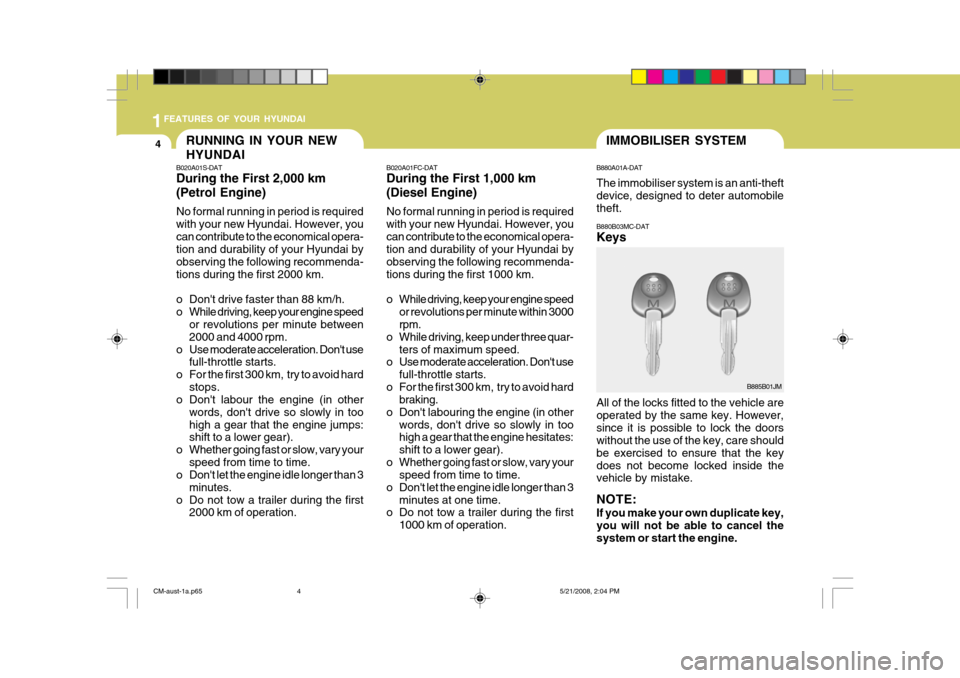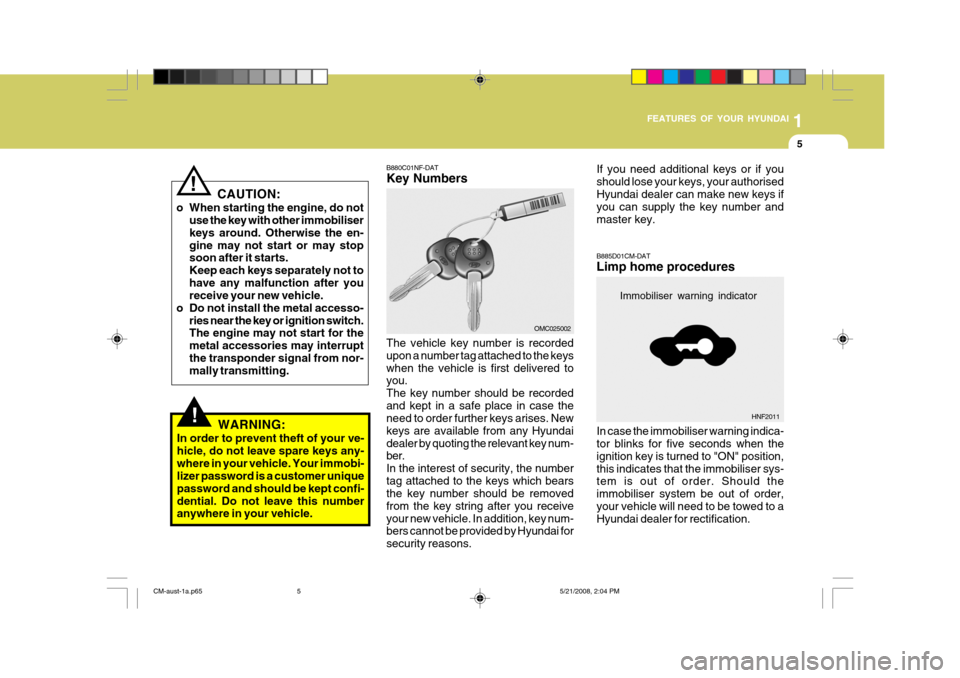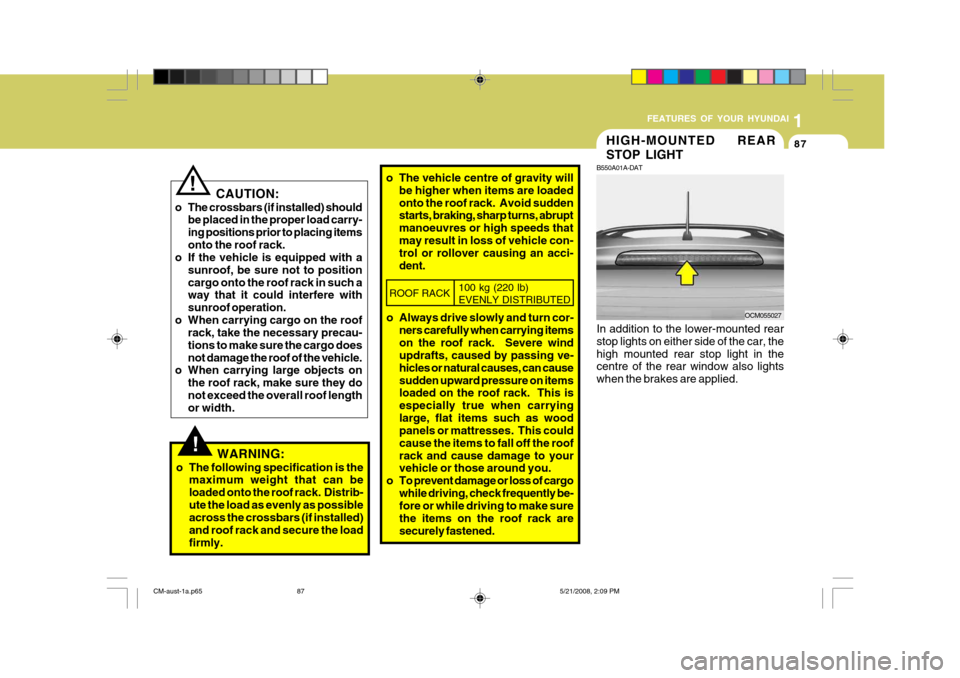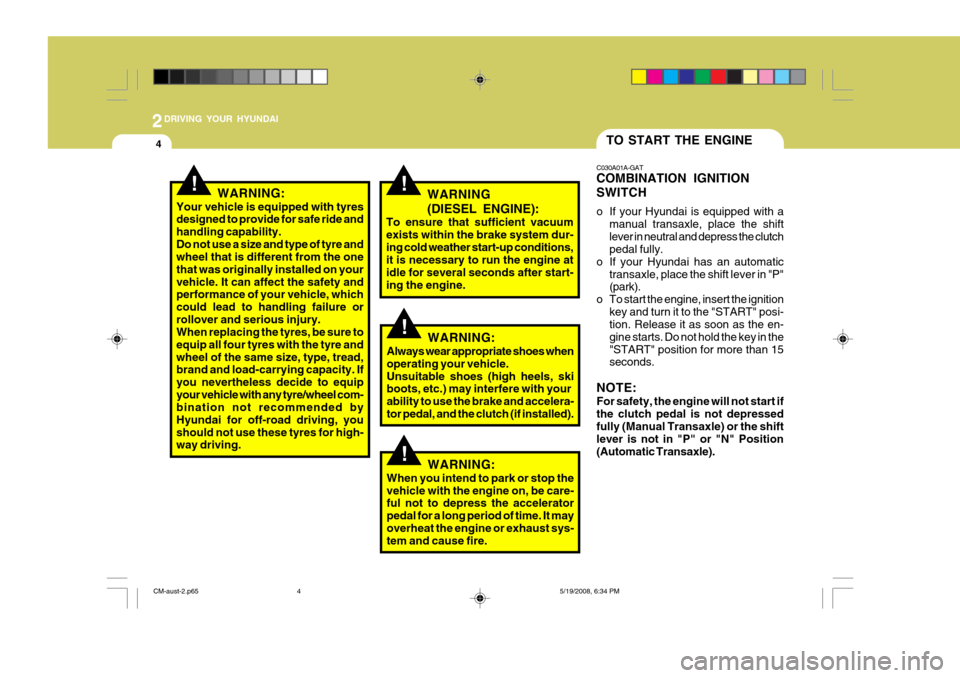2009 Hyundai Santa Fe stop start
[x] Cancel search: stop startPage 13 of 269

1FEATURES OF YOUR HYUNDAI
2
OCM051001R
Unleaded petrol with a Pump Octane Rating of 87 (Research Octane Num-ber 91) or higher must be used in your Hyundai. If leaded petrol is used, it will cause the catalytic converter to become ineffec- tive and the emission control system tomalfunction. This can also result in increased maintenance expense. To avoid accidental use of leaded fuel,the larger nozzle used with leaded petrol at service stations cannot be inserted into the fuel tank opening of your Hyundai.
B010A02CM-DAT Use Unleaded Petrol
FUEL RECOMMENDATIONS
UNLEADED FUEL ONLY
!
Use Diesel Diesel fuel Diesel engine must be operated only on commercially available diesel fuel that complies with EN 590 or comparablestandard. (EN stands for "European Norm"). Do not use marine diesel fuel, heating oils, or non-approved fuel addi-tives, as this will increase wear and cause damage to the engine and fuel system. The use of non-approved fuelsand / or fuel additives will result in a limitation of your warranty rights. Diesel fuel of 52 to 54 cetane is thecorrect rating to use in your Hyundai. If two types of diesel fuel are available, use summer or winter fuel properlyaccording to the following temperature conditions.
o Above -5°C (23°F) ... Summer type
diesel fuel.
o Below -5°C (23°F) ... Winter type diesel fuel.
Watch the fuel level in the tank very carefully : If the engine stops through fuel failure, the circuits must be com- pletely purged to permit restarting. CAUTION:
o Do not let any petrol or water enter the tank. This would make it nec- essary to drain it out and to bleed the lines to avoid jamming theinjection pump and damaging the engine.
o In winter, in order to cut down
incidents due to freezing, paraffinoil may be added to the fuel if the temperature drops to below -10°C.Never use more than 20% paraffin oil.
Biodiesel Commercially supplied biodiesel blends of no more than 5% biodiesel, com- monly known as "B5 biodiesel" may be used in your vehicle if it meets EN14214 or equivalent specifications. (EN stands for "European Norm"). The use of biofuels made from rapeseed methylester (RME), fatty acid methyl ester (FAME), vegetable oil methyl ester (VME) etc. or mixing diesel withbiodiesel will cause increased wear or damage to the engine and fuel system.
CM-aust-1a.p65 5/21/2008, 2:04 PM
2
Page 15 of 269

1FEATURES OF YOUR HYUNDAI
4IMMOBILISER SYSTEM
B880A01A-DAT The immobiliser system is an anti-theft device, designed to deter automobile theft. B880B03MC-DAT Keys All of the locks fitted to the vehicle are operated by the same key. However,since it is possible to lock the doors without the use of the key, care should be exercised to ensure that the keydoes not become locked inside the vehicle by mistake. NOTE: If you make your own duplicate key, you will not be able to cancel the system or start the engine.
B885B01JM
B020A01FC-DAT During the First 1,000 km (Diesel Engine) No formal running in period is required with your new Hyundai. However, youcan contribute to the economical opera- tion and durability of your Hyundai by observing the following recommenda-tions during the first 1000 km.
o While driving, keep your engine speed
or revolutions per minute within 3000 rpm.
o While driving, keep under three quar- ters of maximum speed.
o Use moderate acceleration. Don't use
full-throttle starts.
o For the first 300 km, try to avoid hard braking.
o Don't labouring the engine (in other words, don't drive so slowly in toohigh a gear that the engine hesitates: shift to a lower gear).
o Whether going fast or slow, vary your speed from time to time.
o Don't let the engine idle longer than 3
minutes at one time.
o Do not tow a trailer during the first
1000 km of operation.
RUNNING IN YOUR NEW HYUNDAI
B020A01S-DAT During the First 2,000 km (Petrol Engine) No formal running in period is required with your new Hyundai. However, youcan contribute to the economical opera- tion and durability of your Hyundai by observing the following recommenda-tions during the first 2000 km.
o Don't drive faster than 88 km/h.
o While driving, keep your engine speed
or revolutions per minute between2000 and 4000 rpm.
o Use moderate acceleration. Don't use full-throttle starts.
o For the first 300 km, try to avoid hard stops.
o Don't labour the engine (in other
words, don't drive so slowly in toohigh a gear that the engine jumps: shift to a lower gear).
o Whether going fast or slow, vary your speed from time to time.
o Don't let the engine idle longer than 3
minutes.
o Do not tow a trailer during the first 2000 km of operation.
CM-aust-1a.p65 5/21/2008, 2:04 PM
4
Page 16 of 269

1
FEATURES OF YOUR HYUNDAI
5
B880C01NF-DAT Key Numbers The vehicle key number is recorded upon a number tag attached to the keyswhen the vehicle is first delivered to you. The key number should be recordedand kept in a safe place in case the need to order further keys arises. New keys are available from any Hyundaidealer by quoting the relevant key num- ber. In the interest of security, the numbertag attached to the keys which bears the key number should be removed from the key string after you receiveyour new vehicle. In addition, key num- bers cannot be provided by Hyundai for security reasons. If you need additional keys or if youshould lose your keys, your authorisedHyundai dealer can make new keys if you can supply the key number and master key.
B885D01CM-DAT Limp home procedures In case the immobiliser warning indica- tor blinks for five seconds when the ignition key is turned to "ON" position,this indicates that the immobiliser sys- tem is out of order. Should the immobiliser system be out of order,your vehicle will need to be towed to a Hyundai dealer for rectification.
HNF2011
Immobiliser warning indicator
OMC025002
!
CAUTION:
o When starting the engine, do not use the key with other immobiliser keys around. Otherwise the en-gine may not start or may stop soon after it starts. Keep each keys separately not tohave any malfunction after you receive your new vehicle.
o Do not install the metal accesso-
ries near the key or ignition switch.The engine may not start for the metal accessories may interruptthe transponder signal from nor- mally transmitting.
!WARNING:
In order to prevent theft of your ve- hicle, do not leave spare keys any-where in your vehicle. Your immobi- lizer password is a customer unique password and should be kept confi-dential. Do not leave this number anywhere in your vehicle.
CM-aust-1a.p65 5/21/2008, 2:04 PM
5
Page 60 of 269

1
FEATURES OF YOUR HYUNDAI
49
!
B260G01A-AAT
Low Oil Pressure Warn- ing Light
CAUTION:
If the low oil pressure warning light stays on while the engine is running,serious engine damage may result. The oil pressure warning light comes on whenever there is insufficient oilpressure. In normal operation, it should come on when the ignition switch is turned on, then go outwhen the engine is started. If the oil pressure warning light stays on while the engine is running, there is aserious malfunction. If this happens, stop the car as soon as it is safe to do so, turn off theengine and check the oil level. If the oil level is low, fill the engine oil to the proper level and start the engineagain. If the light stays on with the engine running, turn the engine off immediately. In any instance wherethe oil light stays on when the engine is running, the engine should be checked by a Hyundai dealer beforethe car is driven again.
!
B260H02A-GAT Parking Brake/Low Brake Fluid Level Warning Light
WARNING:
If you suspect brake trouble, have your brakes checked by a Hyundai dealer as soon as possible. Driving your car with a problem in either thebrake electrical system or brake hy- draulic system is dangerous, and could result in a serious injury or death.
Warning Light Operation The parking brake/low brake fluid level warning light should come on when theparking brake is applied and the ignition switch is turned to "ON" or "START". After the engine is started, the lightshould go out when the parking brake is released. If the parking brake is not applied, the warning light should comeon when the ignition switch is turned to "ON" or "START", then go out when the engine starts. If the light comes on atany other time, you should slow the vehicle and bring it to a complete stop in a safe location off the roadway. The brake fluid level warning light indi-cates that the brake fluid level in thebrake master cylinder is low and hy- draulic brake fluid conforming to DOT 3 or DOT 4 specifications should be added.After adding fluid, if no other trouble is found, the car should be immediately and carefully driven to a Hyundai dealerfor inspection. If further trouble is expe- rienced, the vehicle should not be driven at all but taken to a dealer by aprofessional towing service or some other safe method. Your Hyundai is equipped with dual-diagonal braking systems. This means you still have braking on two wheels even if one of the dual systems shouldfail. With only one of the dual systems working, more than normal pedal travel and greater pedal pressure are requiredto stop the car. Also, the car will not stop in as short a distance with only half of the brake system working. If thebrakes fail while you are driving, shift to a lower gear for additional engine brak- ing and stop the car as soon as it is safeto do so.
CM-aust-1a.p65
5/21/2008, 2:06 PM
49
Page 78 of 269

1
FEATURES OF YOUR HYUNDAI
67
B360A01CM-GAT Rear Fog Light Switch To turn on the rear fog lights, push the switch. They will come on when theheadlight switch is in the second posi- tion or the front fog light switch is "ON" position and the key is in the "ON"position.
OCM051019R
REAR WINDOW DEMISTER SWITCH
B380A01CM-DAT The rear window demister and heated outside rearview mirrors are turned onby pushing in the switch. To turn the demister off, push the switch a second time. The rear window demister auto-matically turns itself off after about 20 minutes. To restart the demister cycle, push in the switch again after it hasturned itself off.
OCM052080R
HAZARD WARNING SYSTEM
B370A01A-AAT
The hazard warning system should be used whenever you find it necessary tostop the car in a hazardous location. When you must make such an emer- gency stop, always pull off the road asfar as possible. The hazard warning lights are turned on by pushing in the hazard switch. This causes all turnsignal lights to blink. The hazard warn- ing lights will operate even though the key is not in the ignition. To turn thehazard warning lights off, push the switch a second time.
OCM052075R
CM-aust-1a.p65 5/21/2008, 2:08 PM
67
Page 98 of 269

1
FEATURES OF YOUR HYUNDAI
87HIGH-MOUNTED REAR STOP LIGHT
B550A01A-DAT In addition to the lower-mounted rear stop lights on either side of the car, the high mounted rear stop light in the centre of the rear window also lights when the brakes are applied. OCM055027
!WARNING:
o The following specification is the maximum weight that can be loaded onto the roof rack. Distrib-ute the load as evenly as possible across the crossbars (if installed) and roof rack and secure the loadfirmly. o The vehicle centre of gravity will
be higher when items are loadedonto the roof rack. Avoid sudden starts, braking, sharp turns, abrupt manoeuvres or high speeds thatmay result in loss of vehicle con- trol or rollover causing an acci- dent.
CAUTION:
o The crossbars (if installed) should be placed in the proper load carry-ing positions prior to placing itemsonto the roof rack.
o If the vehicle is equipped with a
sunroof, be sure not to positioncargo onto the roof rack in such a way that it could interfere with sunroof operation.
o When carrying cargo on the roof rack, take the necessary precau-tions to make sure the cargo doesnot damage the roof of the vehicle.
o When carrying large objects on
the roof rack, make sure they donot exceed the overall roof length or width.
!
ROOF RACK 100 kg (220 lb) EVENLY DISTRIBUTED
o Always drive slowly and turn cor-
ners carefully when carrying items on the roof rack. Severe wind updrafts, caused by passing ve- hicles or natural causes, can causesudden upward pressure on items loaded on the roof rack. This is especially true when carryinglarge, flat items such as wood panels or mattresses. This could cause the items to fall off the roofrack and cause damage to your vehicle or those around you.
o To prevent damage or loss of cargo while driving, check frequently be-fore or while driving to make sure the items on the roof rack aresecurely fastened.
CM-aust-1a.p65 5/21/2008, 2:09 PM
87
Page 149 of 269

2DRIVING YOUR HYUNDAI
4
!
TO START THE ENGINE
C030A01A-GAT COMBINATION IGNITION SWITCH
o If your Hyundai is equipped with a manual transaxle, place the shift lever in neutral and depress the clutch pedal fully.
o If your Hyundai has an automatic
transaxle, place the shift lever in "P"(park).
o To start the engine, insert the ignition key and turn it to the "START" posi-tion. Release it as soon as the en- gine starts. Do not hold the key in the"START" position for more than 15 seconds.
NOTE: For safety, the engine will not start if the clutch pedal is not depressed
fully (Manual Transaxle) or the shift lever is not in "P" or "N" Position(Automatic Transaxle).
WARNING:
Your vehicle is equipped with tyres designed to provide for safe ride and handling capability.Do not use a size and type of tyre and wheel that is different from the one that was originally installed on yourvehicle. It can affect the safety and performance of your vehicle, which could lead to handling failure orrollover and serious injury. When replacing the tyres, be sure to equip all four tyres with the tyre andwheel of the same size, type, tread, brand and load-carrying capacity. If you nevertheless decide to equipyour vehicle with any tyre/wheel com- bination not recommended by Hyundai for off-road driving, youshould not use these tyres for high- way driving.
!WARNING:
Always wear appropriate shoes when operating your vehicle.Unsuitable shoes (high heels, ski boots, etc.) may interfere with your ability to use the brake and accelera-tor pedal, and the clutch (if installed).
!WARNING (DIESEL ENGINE):
To ensure that sufficient vacuum exists within the brake system dur-ing cold weather start-up conditions, it is necessary to run the engine at idle for several seconds after start-ing the engine.
!WARNING:
When you intend to park or stop the vehicle with the engine on, be care- ful not to depress the accelerator pedal for a long period of time. It mayoverheat the engine or exhaust sys- tem and cause fire.
CM-aust-2.p65 5/19/2008, 6:34 PM
4
Page 152 of 269

2
DRIVING YOUR HYUNDAI
7
!WARNING:
Be sure that the clutch is fully de- pressed when starting a manual transaxle vehicle. Otherwise there isthe potential to cause damage to the vehicle or injury to someone inside or outside the vehicle as a result ofthe forward or backward movement of the vehicle that will occur if the clutch is not depressed when thevehicle is started.
5. Turn the ignition key to the "START" position and release it when the en- gine starts.
OPERATING THE MANUAL TRANSAXLE
NOTE:
o To shift into reverse, rest the le-ver in neutral for at least 3 sec- onds after your car is completely stopped. Then move the leverinto the reverse position.
o During cold weather, shifting may be difficult until the transaxle lu-bricant has warmed up. This is normal and not harmful to the transaxle.
o If you've come to a complete stop and it's hard to shift into 1st orR(Reverse), put the shift lever in N(Neutral) position and release the clutch. Press the clutch pedalback down, and then shift into 1st or R(Reverse) gear position.
o Do not use the shift lever as a handrest during driving, as this can result in premature wear ofthe transaxle shift forks.
C070A02NF-DAT
This shift pattern is imprinted on theshift knob. The transaxle is fullysynchronised in all forward gears so shifting to either a higher or a lower gear is easily accomplished.When shifting into reverse gear, pull the mis-shift prevention tab and shift into reverse gear position.
OCM053003E
Mis-shift prevention tap
CM-aust-2.p65 5/19/2008, 6:34 PM
7